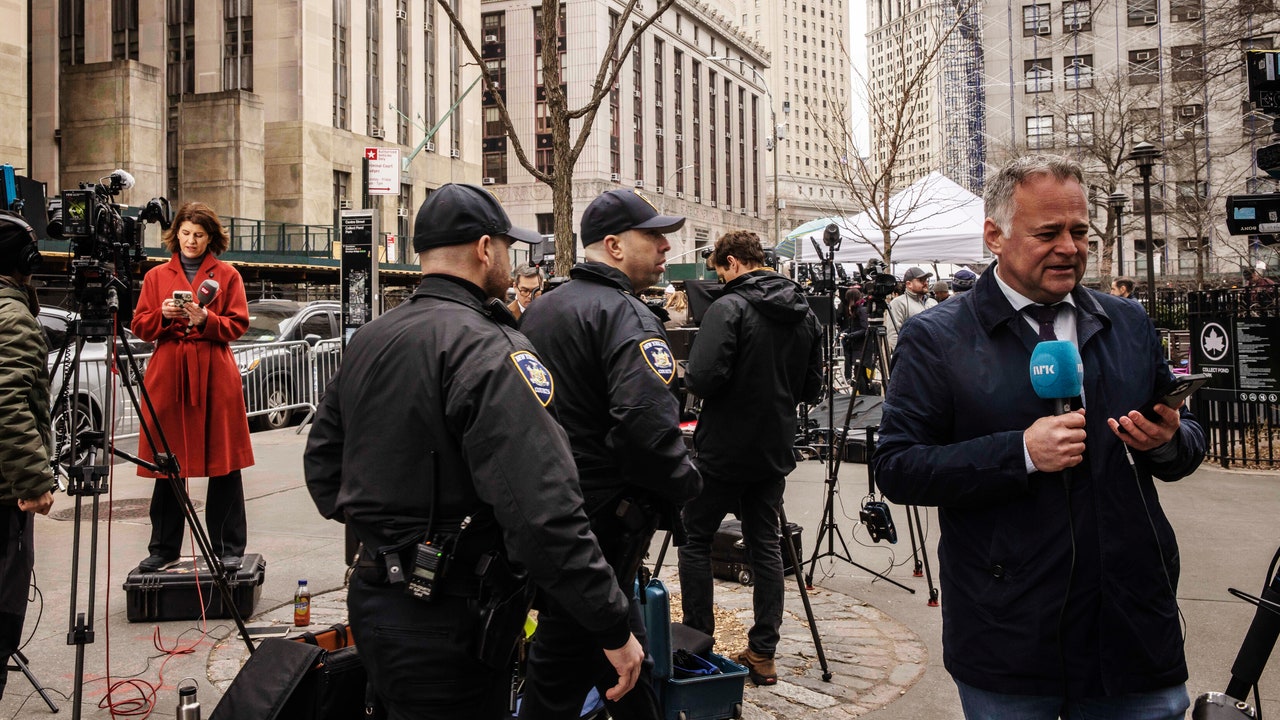On a brisk but sunny Monday morning, Lower Manhattan was swarmed with satellite trucks and news crews. In front of the New York State Supreme Court, two TV reporters were doing news hits, with one noting “a very tight security apparatus” and “huge media contingent” anticipating Donald Trump’s arraignment on Tuesday. But the real media circus was situated some 300 feet away, where, across from Manhattan DA Alvin Bragg’s office, a mass of white tarps lined the street. The names of various outlets—AP, ABC, NY1, Bloomberg, Fox Business, USA Today, Getty—were scrawled on pieces of duct tape adhered to the concrete in front of their respective canopies. I overheard one cameraman explaining to an evidently confused tourist what they were all doing there as he sipped his coffee, and spotted about a dozen cameras inside Collect Pond Park, where a reporter was standing on a bench doing a TV hit. On the other side of the square was a line of parked satellite trucks. “They said 2:15 tomorrow,” I heard an NYPD officer tell his colleague outside 80 Centre Street. “We’re gonna be removing a lot of vehicles too,” she replied.
The city is bracing for the historic arraignment of the former president, whom a Manhattan grand jury voted to indict last week for his role in the 2016 hush-money payout to porn star Stephanie Clifford (aka Stormy Daniels). TV networks were glued to Trump’s motorcade ride to a Palm Beach airport Monday, en route to New York, and Tuesday’s courtroom appearance is sure to dominate cable news. For the reporters who cover the criminal courts, and are accustomed to high-profile proceedings—such as Harvey Weinstein’s 2020 rape trial or the 2011 sexual assault case against former International Monetary Fund chief Dominique Strauss-Kahn, which was later dismissed—the circus surrounding Trump is reaching a whole other level. “I think this is going to dwarf those cases,” said Laura Italiano, who worked at all three New York City tabloids before landing at Insider, where she’s been focusing on Trump’s legal exposure in New York state court. “I’ve been at this for 30 years, and it’s the biggest case in my career.”
The media frenzy had been building for weeks but the indictment came somewhat out of left field, because, as reporters were told a day earlier by sources, the grand jury was set to break for a previously scheduled hiatus, which would push any indictment of Trump until at least the end of April. “Everything was quiet. Some reporters were planning vacations,” said Patricia Hurtado, who’s been covering courts for Bloomberg for 18 years. “As a veteran court reporter—and I’ve covered federal and state courts for decades—this has been the strangest thing, because it’s been a whiplash,” she told me of the inquiry. “It’s been maddening.” Right before the indictment news broke, Italiano told me she’d just filed a story with a headline along the lines of “This Trump Indictment Long Break Is Not a Sure Thing.”
Molly Crane-Newman, who covers the Manhattan federal and state courts for the New York Daily News, was at her desk, located inside the courthouse, when she heard Trump had been indicted. “I shrieked,” she recalled. “I cover all manner of cases in the courts—the high-profile ones, but also the hyperlocal ones,” she said, noting that reporting on indictments being filed is “routine” for her. “The process is going to be the same as it would be for any defendant, but obviously most of the defendants aren’t accompanied by Secret Service when they surrender.”
When I caught up with the three reporters after the indictment news broke, they were all focused on making sure they’d be able to do their jobs with the rest of the press corps parachuting in. There are a limited number of seats in the courtroom, and Italiano said Insider’s lawyers were “ready preemptively, in case there’s any kind of objectionable limitation on access,” like a pool situation where there’s one camera and one print reporter—“the kind of nightmare that keeps me awake,” as she put it. Crane-Newman pointed to past high-profile trials like Weinstein’s, or El Chapo’s in federal court in Brooklyn. “In those instances, reporters who don’t have in-house credentials have been required to start lining up outside the courthouse the night before,” she said, noting that she was among them for El Chapo, arriving at 11 p.m. one night before. Even that wasn’t enough, she noted: “I was the first reporter in overflow.”
For Weinstein’s trial, Hurtado said she got up at 4:30 a.m.—by which time the line was already around the block—to make sure she was there in time. In preparation for Tuesday, Hurtado joked about asking a lawyer she knows, who lives in an apartment building next door to the courthouse, whether she could crash on their floor in a sleeping bag. “It’s a big slog,” she said. Press access to documents may also be a challenge, as it has been with previous high-profile state court cases, said Hurtado, because while the federal court system is electronic, the state court still operates largely on paper. During Weinstein’s trial, reporters were taking photos of the filing with their phones, Hurtado said. “The courthouse system is kind of trapped in 1923,” she said.
The chaos might not be limited to the press swarm, as a threat of potential unrest has officers on high alert. Last month, when Trump predicted he would be “arrested on Tuesday,” the former president called on supporters to “protest” and “take our nation back.” At least one of his sycophants in Congress has heeded the call, as Representative Marjorie Taylor Greene tweeted that she’s coming to New York on Tuesday to “protest this unprecedented abuse of our justice system and election interference,” and will be headlining a rally planned by the New York Young Republican Club at a nearby park.
This post has been updated.
